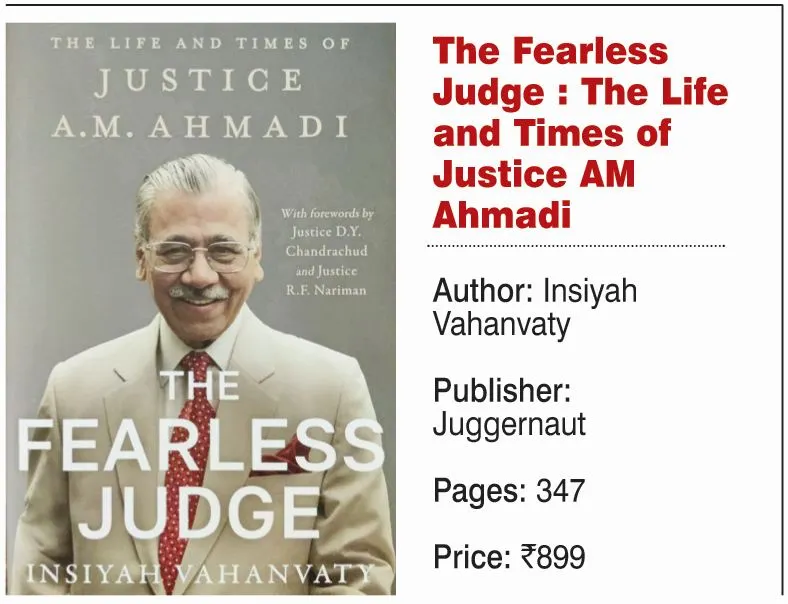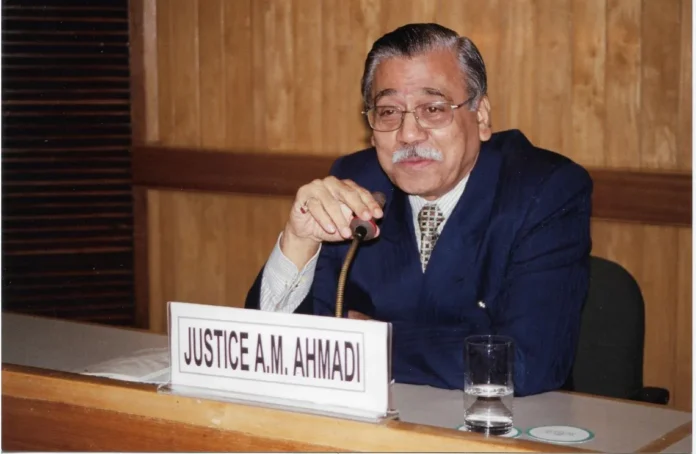Vikram Kilpady (VK): As his biographer, what would you term Justice Ahmadi’s greatest achievement as the chief justice of India?
Insiyah Vahanvaty (IV): Though I can’t speak of a single greatest achievement, I can speak about his legacy. That is his greatest gift to our country—the idea of an India where the Constitution reigns supreme, and equality and justice is available for all. A country where secularism is preached and practiced by both the State and individuals. It is this gift that he has left behind for us through his judgments and his life’s work. It is to these ideals that he dedicated his entire life.
VK: The pendency of cases have trailed the courts since long. How did Justice Ahmadi view this and what were his efforts to reduce pendency?
IV: Justice Ahmadi was the chief justice of India from October 25, 1994 to March 24, 1997. In this duration of two almost two years and five months, the number of pending cases came down from 1,20,000 to 18,000. He used to say: “Don’t get scared by numbers.” And he felt pendency was not an insurmountable issue.

He was a judge at the city civil court in Gujarat when the then chief justice of the Gujarat High Court handed over a lot of pending darkhast (execution) cases to deal with. As an experiment, Justice Ahmadi categorised cases in groups and assigned the hearing of a single group on the same day. It worked well and he could clear some 1,500 cases in a month. That was a valuable lesson as his career progressed.
Once chief justice of India, he applied the same method of categorisation and assigning cases to different benches while maintaining the bench composition until all cases in a particular group were disposed of. This led to greater specialisation among benches. It was found that after spending a little time on the first few cases in a group, the benches were able to gain momentum and move through the remaining cases quickly as they were all similar and therefore bracketed together. He also grouped courts as fast-track, medium-track and slow-track for further organisation.
Digitisation in the courts is much discussed nowadays. But the pioneer of this was Justice Ahmadi. He took the first steps in digitisation by copying judgments on floppies so that they are accessible to anyone who may want them. Be they for scholars, lawyers, journalists and even the people. Taking one step from floppy to further mode of recording verdicts was now made easier. The giant step of going from analogue to digital was opposed by many, but Justice Ahmadi took the leap, making it easier for future chief justices to move ahead.
He also introduced the first computers in the Supreme Court by phasing out typewriters. Initially, the Court registry resisted this change because they were comfortable with their typewriters. In an almost comical move, their typewriters were swapped for computers when the clerks had left for the day.
VK: What were Justice Ahmadi’s views on the Ayodhya Babri case? How did he envision justice in this case?
IV: He was quite unhappy. He was upset that none of the perpetrators in the Babri Masjid demolition case were punished. Justice Ahmadi disagreed with the permission granted by the Supreme Court to the Uttar Pradesh government’s application to hold kar seva at the disputed site. Further, in the SC’s Ismail Faruqui judgment, Justice SP Bharucha wrote the minority view for himself and on behalf of Justice Ahmadi that provisions of Section 7 of the Acquisition of Certain Area at Ayodhya Act, 1993, were referred to in support of the finding that the Act is skewed to favour one religion against another. This position of the Court was distressing for both the dissenting judges.
Justice Ahmadi maintained that ownership of the disputed land was a complicated issue as there are layers and layers of history in a civilisation as old as India. How far back can one go or will go? And how can such things be proved beyond reasonable doubt? That’s why a statute of limitations is necessary to maintain peace.

Further, had it been left to Justice Ahmadi, the Babri dispute would not have entered the courtroom. He had made a strong case for exploring the route of mediation in the dispute with the then Chief Justice of India (Justice MN Venkatachaliah). If that had been done, the Babri Masjid case would not have never entered the courts for litigation. Litigation is adversarial, especially for an issue as sensitive as the demolition of the Babri Masjid and the ownership of the land. Justice Ahmadi’s view was that in finding a mutually acceptable solution outside the courts, the country could be spared of generations of bad blood and sectarian sentiment.
VK: As a Dawoodi Bohra from Gujarat, how did he view the religious polarisation in India, in general, and in Gujarat, in particular, the post-Godhra riots?
IV: Justice Ahmadi was an Oxford dictionary secularist. Religious strife pained him. Having spent more than 50 years in Gujarat, he had seen several religious riots. The state had polarised long before Narendra Modi became the Gujarat chief minister. The polarisation was so stark that it needed leaders who could speak of unity and fraternity, but six months into Modi’s term as CM, the post-Godhra riots happened. That was very painful personally for Justice Ahmadi, to see secularism sacrificed for electoral gain.
The Judiciary is a powerful institution, it’s the only one that can take on the Executive. Only the Judiciary can enforce the rule of law when extra-legal measures are carried out by the State or people. After retirement, Justice Ahmadi urged the Judiciary to take cognisance of religious violence, such as mob violence, to punish perpetrators for people to gain faith in the system. If cases of religious violence are taken up suo motu, then such incidents will stop happening or at least come down drastically. He also cautioned that should the Judiciary fail to punish the perpetrators of religious violence, it would risk losing the trust of the communities that are victimised.
VK: Vis-a-vis Kashi and Mathura, did Justice Ahmadi foresee challenges to the Places of Worship (Special Provisions) Act, 1991?
IV: Not in the beginning, Justice Ahmadi had great faith in the State that it would do the right thing for the people and the country. But later when he retired, especially after the Ayodhya judgment in 2019, he wondered if the State can maintain and continue to do the right things. The demolition of the Babri Masjid—and the subsequent verdict—has blown the door open. He then anticipated challenges to this Act. If the Ayodhya judgment had not gone this way, then perhaps he would not have felt so.
VK: What were Justice Ahmadi’s views on the resilience of the Constitution and the Republic in his later years?
IV: Justice Ahmadi was an eternally optimistic man. His faith in the Constitution never wavered even for a brief moment. He used to say: “Giants gave us the Constitution, it is our duty to protect it from the pygmies who want to take it down.” Later on in his life, he was disappointed at the turn of events in the country. But even so, that didn’t shake his faith in the people, the Constitution and the Republic. He had immense faith in the people of the country. He would often say: “It is the people of India who have kept the Constitution alive, I give them a lot of credit.”
VK: How difficult or easy was it to write about your grandfather?
IV: Writing the book was a very intense and emotional process. I had completely underestimated the project. As my nanajaan and de facto father, I had intimate knowledge of him. But if I had to do justice to the book, I had to speak to a lot of his contemporaries, judges, and lawyers, I realised he was a much more multi-faceted man than I knew him to be. I knew just one part of the man. For me, it was a journey of discovery.
Through the process, I learnt several details of his life. Being a Muslim, Justice Ahmadi also faced a lot of communal prejudice. When he was appointed a judge at the Ahmedabad city civil and sessions court when he was 32, lawyers in Gujarat organised a strike against his promotion. Questions were even raised in the Gujarat Assembly. It was unprecedented, he was Muslim and very young. Senior lawyers were up in arms because if they became judges later, they would have to defer to him since he was senior to them though much younger in age. Later, when his name was recommended for elevation to the Supreme Court, once again, his religion came up and an attempt was made to derail his appointment.
The book also made me truly understand the legal statesman Justice Ahmadi is. It also helped me put into perspective many of my childhood memories. For example, when Babri Masjid fell, the discussions around the dinner table were muted, he was pained and immersed himself in work. That was also a pointer: If you didn’t see him much, it would usually mean he was upset and had locked himself in the office attending to work.
I would hear him refer to the Supreme Court’s role during family conversations, but I didn’t understand what he meant then. Now of course, I know he was referring to the permission for the kar seva that had been granted despite warnings that it was intended to be a violent one. There are several such instances I have shared in the book.
VK: Could you explain why the first chapter in the book is titled The Black Sheep of The Family?
IV: In his childhood, Justice Ahmadi was a very long away from what he would be as a judge. He was mischievous and boisterous like most boys. He played a lot of pranks.
Growing up in Surat, Justice Ahmadi used to spend a lot of time with what his parents may have thought of rough boys. He was always game for some activity or the other. He played cricket all the time, any time. Some of those boys he played with eventually went on to become very successful, playing for the Indian national team, including Salim Durani and Jasubhai Patel.
His father was a sub-judge in British India, and as expected, he was very proper and immaculate. Justice Ahmadi was not academically inclined at all and his father was convinced he would not have a bright future.


